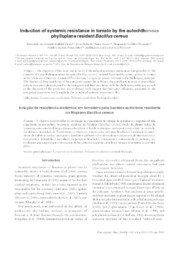Induction of systemic resistance in tomato by the autochthonous phylloplane resident Bacillus cereus.
Induction of systemic resistance in tomato by the autochthonous phylloplane resident Bacillus cereus.
Author(s): HALFELD-VIEIRA, B. de A.; VIEIRA JUNIOR, J. R.; ROMEIRO, R. da S.; SILVA, H. S. A.; BARACT-PEREIRA, M. C.
Summary: The objective of this work was to verify if the induced resistance mechanism is responsible for the capacity of a phylloplane resident bacteria (Bacillus cereus), isolated from healthy tomato plants, to control several diseases of this crop. A strain of Pseudomonas syringae pv. tomato was used as the challenging pathogen. The absence of direct antibiosis of the antagonist against the pathogen, the significant increase in peroxidases activity in tomato plants exposed to the antagonist and then inoculated with the challenging pathogen, as well as the character of the protection, are evidences wich suggest that biocontrol efficiency presented by the antagonist in previous works might be due to induced systemic resistance (ISR).
Publication year: 2006
Types of publication: Journal article
Unit: Embrapa Rondônia
Observation
Some of Embrapa's publications are published as ePub files. To read them, use or download one of the following free software options to your computer or mobile device. Android: Google Play Books; IOS: iBooks; Windows and Linux: Calibre.
Access other publications
Access the Agricultural Research Database (BDPA) to consult Embrapa's full library collection and records.
Visit Embrapa Bookstore to purchase books and other publications sold by Embrapa.

